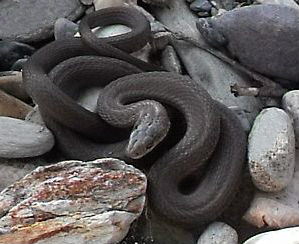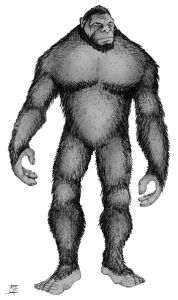 In some Muskogee accounts, “tie snake” is basically synonymous with “horned serpent.” In other versions of the myth, they are two separate creatures, of which the tie snake properly so called is much smaller than the horned serpent, and not quite as malevolent.
In some Muskogee accounts, “tie snake” is basically synonymous with “horned serpent.” In other versions of the myth, they are two separate creatures, of which the tie snake properly so called is much smaller than the horned serpent, and not quite as malevolent.
Tie snakes are most often associated with Muskogee culture, but they are also known, for example, to the Hitchiti, Yuchi, Natchez, and Chickasaw. In the Muskogee language, they are called estakwvnayv (ee-stah-kwuh-nah-yuh). In outward appearance, they aren’t terribly different from any ordinary snake. They are usually either black or dark blue in color. In some legends, their head is crooked over like the beak of a hawk.
But appearances can be deceiving. Tie snakes are almost always depicted as immensely strong. They often drag humans underwater, so be careful when you go near the water!
Tie snakes also exert control over water. One account has a tie snake summoning a flood large enough to overwhelm an entire town. Furthermore, these creatures are often shape-shifters. By some accounts, the tie snake was originally a man who was transformed into a serpent-like being after eating taboo food.
The most powerful tie snakes are expert animal charmers, able to command ordinary snakes to do their bidding. The “king of the tie snakes” is an almost godlike underworld being who claims to know “all things that are under the earth.” This figure might be depicted seated on a throne made of writhing snakes. He can be both frightening and demanding, but also willing to assist those who are worthy.

![Judaculla Rock, photo by Onmountain [CC BY-SA 3.0], via Wikimedia Commons](https://intothewonder.files.wordpress.com/2015/07/800px-close_up_of_judaculla_rock_nc_taken_in_july_2013.jpg?w=300&h=169)

